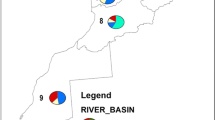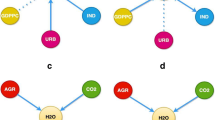Abstract
Agriculture and natural resources have a mutual relationship with each other. The purpose of this study was to evaluate forward and backward relationship between natural resources and agricultural development. The relationship between the consumption of water and agricultural value added per capita income has been studied in order to obtain the forward relationship, and the relationship between carbon dioxide emissions and per capita income of the Iran’s agricultural sector has been assessed in order to obtain backward relationship. To test these relationships, the Kuznets theory is used. Therefore, Iran’s provinces information from 2001 to 2013 was used and models were estimated by using the panel data and spatial econometric. Results showed that there was an inverted U relationship between per capita income and water consumption and carbon dioxide emissions. Also, spatial estimation showed that both water consumption and carbon dioxide (CO2) emissions in agricultural sector had a direct relationship with the value of these two variables in the neighboring areas.






Similar content being viewed by others
References
Al-Mulali U, Weng-Wai C, Sheau-Ting L, Mohammed AH (2015) Investigating the environmental Kuznets curve (EKC) hypothesis by utilizing the ecological footprint as an indicator of environmental degradation. Ecol Indic 48:315–323
Anselin L (1988) Spatial econometrics, methods and models. Kluwer, Boston
Anselin L (2001) Spatial econometrics, a companion to theoretical econometrics. Blackwell, Oxford, pp 310–330
Anselin L, Arribas-Bel D (2013) Spatial fixed effects and spatial dependence in a single cross-section. Pap Reg Sci 92(1):3–17
Anselin L, Le Gallo J, Jayet H (2008) Spatial panel econometrics. In: Matyas L, Sevestre P (eds) The econometrics of panel data, fundamentals and recent developments in theory and practice, 3rd edn. Springer, Berlin
Arellano M, Bond S (1991) Some tests of specification for panel data: Monte Carlo evidence and an application to employment equations. Rev Econ Stud 58:277–297
Arellano M, Bover O (1995) Another look at the instrumental variable estimation of error-components models. J Econom 68(1):29–51
Aslanidis N (2009) Environmental Kuznets curves for carbon emissions: a critical survey. http://ageconsearch.umn.edu/bitstream/54299/2/75-09.pdf
Auffhammer M, Carson RT (2008) Forecasting the path of China’s CO2 emissions using province level information. J Environ Econ Manag 55:229–247
Baltagi B (2009) Econometric analysis of panel data. Wiley, London
Barbier E (2004) Water and economic growth. Econ Rec 80(248):1–16
Beckerman W (1992) Economic growth and the environment: whose growth? Whose environment? World Dev 20(4):481–496
Bhattarai M (2004) Irrigation Kuznets curve governance and dynamics of irrigation development: a global cross-country analysis from 1972 to 1991. International Water Management Institute, Colombo
Birkelof LC (2010) Exploring differences in expenditure for the functionally impaired: neighborhood interaction and the federal structure. Ann Reg Sci 44(1):185–204
Blonigen BA, Davies RB, Waddell GR, Naughton HT (2007) FDI in space: spatial autoregressive relationships in foreign direct investment. Eur Econ Rev 51:1303–1325
Blundell R, Bond S (1998) Initial conditions and moment restrictions in dynamic panel data models. J Econom 87(1):115–143
Boubacar I (2015) Spatial determinants of U.S. FDI and exports in OECD countries. Econ Syst 40(1):135–144
Burnett JW, Bergstrom JC (2010) U.S. State-level carbon dioxide emissions: A spatial temporal econometric approach of the environmental Kuznets curve. Faculty Series No 96031 from the University of Georgia, Department of Agricultural and Applied Economics
Central Bank of Iran Database, 2014
Chen CC (2010) Spatial inequality in municipal solid waste disposal across regions in developing countries. Int J Environ Sci Tech 7(3):447–456
Choi I (2001) Unit root tests for panel data. J Int Money Finance 20:249–272
Cole MA (2004) Economic growth and water use. Appl Econ Lett 11:1–4
Costantini V, Mazzanti M, Montini A (2013) Environmental performance, innovation and spillovers. Evidence from a regional NAMEA. Ecol Econ 89:101–114
Debarsy N, Ertur C, LeSage JP (2011) Interpreting dynamic space–time panel data models. Stat Methodol 9(1–2):158–171
Donfouet HPP, Jeanty WP, Malin E (2013) A spatial dynamic panel analysis of the environmental Kuznets curve in European countries. Working paper. http://crem.univ-rennes1.fr/wp/2013/201318.pdf
Duarte R, Pinilla V, Serrano A (2011) Looking backward to look forward: water use and economic growth from a long-term perspective. Working paper AEHE DT-1104. Asociación Española de Historia Económica
Duarte R, Pinilla V, Serrano A (2013) Is there an environmental Kuznets curve for water use? A panel smooth transition regression approach. Econ Model 31(2013):518–527
Elhorst JP (2011) Spatial panel model. Working paper. http://www.york.ac.uk/media/economics/documents/seminars/2011-12/Elhorst_November2011.pdf
Fredriksson P, Millimet DL (2002) Strategic interaction and determination of environmental policy across U.S. States. J Urban Econ 51(1):101–122
Germani AR, Morone P, Testa G (2014) Environmental justice and air pollution: a case study on Italian provinces. Ecol Econ 106(2014):69–82
Ghorbani R, Mondani F, Amirmoradi S, Feizi H, Khorramdel S, Teimouri M, Sanjani S, Anvarkhah S, Aghel H (2011) A case study of energy use and economical analysis of irrigated and dryland wheat production systems. Appl Energy 88:283–288
Gleick P (2003) Water use. Annu Rev Environ Resour 28:275–314
Goklany IM (2002) Comparing 20th century trends in U.S. and global agricultural water and land use. Water Int 27(3):321–329
Grossman GM, Krueger AB (1991) Environmental impact of a North American free trade agreement. National Bureau of Economic Research working paper 3914. NBER, Cambridge, MA
Hemati A, Mehrara M, Sayehmiri A (2011) New vision on the relationship between income and water withdrawal in industry sector. Nat Resour 2(3):191–196
Im KS, Pesaran MH, Shin Y (2003) Testing for unit roots in heterogeneous panels. J Econ 115:53–74
Iran Water Resources Management Company Database, 2014
Jia S, Yang H, Zhang S, Wang L, Xia J (2006) Industrial water use Kuznets curve: evidence from industrialized countries and implications for developing countries. J Water Resour Plan Manag 132(3):183–191
Kaika D, Zervas F (2013a) The environmental Kuznets curve (EKC) theory-part A: concept, causes and the CO2 emissions case. Energy Policy 62:392–1402
Kaika D, Zervas F (2013b) The environmental Kuznets curve (EKC) theory. Part B: critical issues. Energy Policy 62:1403–1411
Kander A, Lindmark M (2004) Energy consumption, pollutant emissions and growth in the long run: Sweden through 200 years. Eur Rev Econ Hist 8:297–335
Katz D (2015) Water use and economic growth: reconsidering the environmental Kuznets curve relationship. J Clean Prod 88:205–213
Keller W (2004) International technology diffusion. J Econ Lit 42(3):752–782
Kraft J, Kraft A (1978) On the relationship between energy and GNP. J Energy Dev 3:401–403
Kuznets S (1955) Economic growth and income inequality. Am Econ Rev 65:1–28
Maddala GS, Wu SA (1999) Comparative study of unit root tests with panel data and a new simple test. Oxf Bull Econ Stat 108:1–24
Maddison D (2006) Environmental Kuznets curves: a spatial econometric approach. J Environ Econ Manag 51(2):218–230
Marrero GA (2010) Greenhouse gases emissions, growth and the energy mix in Europe. Energy Econ 32(6):1356–1363
Mirshojaeian Hosseini H, Rahbar F (2011) Spatial environmental Kuznets curve for Asian countries: study of CO2 and PM10. J Environ Stud 37(58):1–14 (in Persian)
Molaei M, Kavoosi Kelashemi M, Rafiee H (2010) Investigation of cointegration relationship between per capita GDP and per capita CO2 emission and existence of environmental Kuznets curve for CO2 in Iran. Environ Sci 8(1):205–216 (in Persian)
Murdoch JC, Sandler T, Sargent K (1997) A tale of two collectives: sulfur versus nitrogen oxides emission reduction in Europe. Economica 64:281–301
Najafi Alamdarlo H (2016) Spatial and temporal factors affecting agricultural trade in European Union (EU) and Economic Cooperation Organization (ECO). J Agric Sci Tech 18(Supplementary) (in press)
Najafi Alamdarlo H, Ahmadian M, Khalilian S (2016) Groundwater management at Varamin plain: the consideration of stochastic and environmental effects. Int J Environ Res 10(1):21–30
Nakagawa H, Harada T, Ichinose T, Takeno K, Matsumoto S, Kobayashi M, Sakai M (2007) Bio methanol production and CO2 emission reduction from forage grasses, trees, and crop residues. JARQ 41(2):173–180
Nakicenovic N, Alcamo J, Davis G, Vries B, Fenhann J, Gaffin S, Gregory K, Grübler A, Jung TY, Kram T, Rovere E, Michaelis L, Mori S, Morita T, Pepper W, Pitcher H, Price L, Riahi K, Roehrl A, Rogner H, Sankovski A, Schlesinger M, Shukla P, Smith S, Swart R, Rooijen S, Victor N, Dadi Z (2000) Special report on emissions scenarios. In: Nakicenovic N, Swart R (eds) IPCC special reports. IPCC
Ozkan B, Fert C, Karadeniz F (2007) Energy and cost analysis for greenhouse and open-field grape production. Energy 32:1500–1504
Panayotou T (1993) Empirical tests and policy analysis of environmental degradation at different stages of economic development. Working paper WP238, Technology and Employment Program, International Labor Office, Geneva
Rock MT (1998) Freshwater use, freshwater scarcity, and socioeconomic development. J Environ Dev 7(3):278–301
Rupasingha A, Goetz SJ, Debertin DL, Pagoulatos A (2004) The environmental Kuznets curve for US counties: a spatial econometric analysis with extensions. Pap Reg Sci 83:407–424
Shahbazi K, Hamidi Razi D, Feshari M (2015) Investigating the factors affecting air pollution emissions in Caspian Sea countries: panel spatial Durbin model. J Environ Stud 41(1):107–127 (in Persian)
Statistical Center of Iran Database, 2014
Vaseghi E, Esmaeili A (2010) Investigation of the determinant of CO2 emission in Iran (using environmental Kuznets curve). J Environ Stud 35(52):99–110 (in Persian)
WWAP (2009) The United Nations world water development report 3: water in a changing world. UNESCO Publishing, Paris
Author information
Authors and Affiliations
Corresponding author
Electronic supplementary material
Below is the link to the electronic supplementary material.
Rights and permissions
About this article
Cite this article
Najafi Alamdarlo, H. Water consumption, agriculture value added and carbon dioxide emission in Iran, environmental Kuznets curve hypothesis. Int. J. Environ. Sci. Technol. 13, 2079–2090 (2016). https://doi.org/10.1007/s13762-016-1005-4
Received:
Revised:
Accepted:
Published:
Issue Date:
DOI: https://doi.org/10.1007/s13762-016-1005-4




